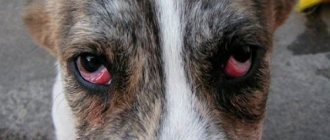In dogs, concussions are most often the result of a traffic accident, a fall from a ladder or from a height. This is always associated with loss of consciousness.
We can talk about three degrees of concussion. In the case of the first, a temporary disturbance of consciousness is observed, which disappears within 15 minutes. In the case of the second, it takes more than 15 minutes. The third stage is characterized by loss of consciousness.
Due to the lack of verbal communication between you and your dog, it is important that you pay attention to his behavior and monitor him closely if he is involved in an accident. If left untreated, a concussion can lead to long-term brain damage and, in worst cases, death.
Symptoms of Concussion in Dogs
Seeing your dog hit his head, or even if you find him exhibiting these symptoms, requires immediate action. Most symptoms appear within the first few hours after the accident, sometimes even minutes, but others can take days.
- difficulty walking
- standing problem
- paralysis
- vomit
- loss of appetite
- loss of bowel function
- disorientation and confusion
- lethargy and sleeping much more than usual
- loss of consciousness or in more serious cases coma
- dilated pupils or changes in the eyes
- any signs of shock
- convulsions and trembling
- bleeding from the nose or ears
- acting strange, distant, or depressed
- any kind of cut or bruise on the head
- labored breathing
Any of these symptoms could indicate a head injury, which means it is highly recommended that you call your veterinarian immediately.
Symptoms
The first signs of a concussion in dogs are refusal to eat, lethargy, nausea, and vomiting. The pet loses coordination of movements, this manifests itself through a staggering gait or spinning around its axis.
With a mild degree of damage, the animal quickly comes to its senses and signs of damage disappear after some time.
Dogs with more severe concussions may experience the following symptoms:
- Severe migraine. The pet either does not make any movements with its head or shakes it vigorously from side to side.
- Brief loss of consciousness.
- Changes in the animal's behavior. It may become distracted and whine. Aggression and an inadequate reaction to others and its owner may appear (the pet may growl or rush).
- Drowsiness.
- Slow reaction.
- Dilated pupils.
Symptoms of a severe concussion in dogs include temporary loss of smell, hearing, or vision. With extensive brain damage, a concussion is accompanied by symptoms: dilated eyes, dilated pupils, trembling of the eyeballs, involuntary emptying of the bladder and bowels, long-term loss of consciousness. This condition can be fatal. If your dog exhibits such symptoms, you should immediately contact a veterinarian.
Causes of concussion
- car crashes;
- being hit by a car on the street;
- being in a vehicle during a traffic accident;
- falls from great heights (mainly in smaller dogs that are carried in a purse or in the arms);
- hitting walls or trees;
- attacks by other dogs.
Although dogs have thicker heads, some smaller breeds are more susceptible to concussions through the shape of their skull. Some breeds have open fontanelles, the space between the bones of the skull, which makes a concussion much more likely.
This can be associated with the soft and underdeveloped skull of a small child. In these breeds, it is best to take the dog directly to the vet rather than wait for symptoms to develop.
Prevention
How to prevent concussions in animals? To protect your dog from injury, the following recommendations must be followed:
- Do not let your pet go for independent walks.
- During walks, let your dog off the leash only in safe places.
- Outdoor games and training sessions can only be carried out in open spaces. It is necessary to ensure that there are no large stones or trees nearby.
- You should remove all dangerous objects in the apartment that could fall on the dog’s head.
Following these simple measures will help keep your pet healthy.
Types of Concussion in Dogs
There are four common types of brain injuries in dogs, concussions being just one of them.
- A concussion is a severe injury to the brain caused by a strong blow. This is the most common type of traumatic brain injury in dogs.
- Contusion is a blow that is delivered directly to the brain, causing internal bleeding.
- Impact-reaction - characterized by two contusions: one at the site of impact, and the second on the other side, caused by a contusion of the brain into the skull as a result of a direct blow.
- Diffuse axonal syndrome is a tremor or rotation that destroys nerve tissue and causes severe brain damage.
Diagnostics
If a concussion is suspected, the veterinarian will order the following tests:
- MRI of the brain. This test helps determine the extent of traumatic injuries.
- X-ray. Using this method, bone damage can be determined.
- Electroencephalogram. The examination helps to identify the hidden consequences of injury.
It is necessary to show your pet to a veterinary ophthalmologist for a fundus examination, as well as a neurology specialist to assess reactions to stimuli.
Treatment
If your dog has a bad fall or accident and exhibits any of the above signs, it is very likely that he has a concussion. Now that you have identified the problem, you need to treat your concussion as quickly as possible. Just like humans, dogs also have a treatment protocol.
First, you need to calm your dog so that he doesn't get too excited. If she is scared or anxious, you will have a hard time determining whether she actually has a traumatic brain injury.
In some cases, your dog may not even be injured. You won't know until you calm him down and make sure he's okay. If there is a visible wound you should take your dog to the vet immediately. Even if there is no head injury, if your dog is showing symptoms, take him to the vet as well.
Since your dog may not report pain or confusion, in the event of a head injury, it's best to play it safe and take him to the hospital.
When it arrives, the veterinarian will run a series of tests on your dog. Basically, the veterinarian will draw blood and ensure that all of your dog's organs are working properly, eliminating the possibility of shock, before proceeding.
The shock is extremely severe and results in long-term damage and death. If you notice your dog is in shock, raise his head and watch his breathing in case he needs to perform CPR.
How to perform CPR on a dog:
- Lay the dog on its side on a flat surface.
- Place your hand on most of the dog's chest.
- With your arms secured, squeeze your dog's chest to a quarter of its width at a steady rate of 80 compressions per minute.
- Continue CPR until your dog is conscious, breathing on his own, or a trained veterinarian or staff can provide compressions.
Knowing these steps can save your dog in an emergency!
Signs of shock are:
- Limited mental performance or activity
- blue gums
- irregular heartbeat
- low temperature
- rapid breathing
- shallow pulse
- convulsions
After ruling out shock and evaluating the heart and lungs, your veterinarian may give your dog oxygen and fluid infusions to prevent nausea and relieve some symptoms.
Your dog may also be prescribed some anti-inflammatory medications to reduce and prevent brain inflammation and to make your dog more comfortable.
Certain neurological tests may be performed to better assess the severity of a concussion. Some severe cases require surgery to correct brain bleeding or other internal injuries that accompany a concussion.
Like people who suffer a head injury, your dog will likely be kept overnight for observation. In severe cases, your dog may remain in the hospital for several days.
This time allows the veterinarian to determine how severe the brain swelling may be, rule out any type of internal bleeding, and closely monitor any symptoms that arise.
It also prevents secondary injuries, which can be more traumatic and cause more serious long-term consequences than the initial head injury. Other than these few steps, there really isn't much that can be done for a head injury. Observation and rest are key aspects of the healing process.
Dislocations
A dislocation is an injury that affects a joint. When a dislocation occurs, the natural position of the articular surfaces is disrupted, and they cannot spontaneously return to their place. Characteristic features:
- Swelling at the joint (swelling and inflammation occur at the site of tissue damage).
- Soreness of the damaged area.
- Restricted mobility in a joint or, conversely, unnatural mobility (the limb bends in a way it shouldn’t).
When a dislocation occurs, it is important to ensure basic immobilization of the animal's limb so that bone displacement does not cause additional damage. After this, the dog should be taken to the clinic as quickly as possible - under no circumstances should you adjust the dislocation yourself. Severe dislocations can be extremely painful, so pain relief for a dog with this type of injury is given quite often - this helps to avoid shock.
Note! It is also undesirable to apply cold to the site of dislocation - cooling the joint can make it difficult to reduce it. Therefore, it is necessary to cool the injury site only for a short period of time, and only if the animal feels severe discomfort.
Long-term effects of concussion
If treated promptly and correctly, the long-term effects of your dog's traumatic brain injury may be minimal. Immediate consequences may include loss of consciousness, confusion and, in severe cases, loss of heartbeat and breathing.
Typically, with proper care, there are no real long-term consequences and your dog will return to normal. If a concussion is left untreated or if a secondary injury occurs, your dog may experience low mental alertness in the future.
Caring for your dog after a concussion is critical to keeping your dog healthy and the dog you've always loved.
First aid
If your dog has a concussion, it definitely needs help. To do this, perform the following steps:
- You need to remove the dog's collar, muzzle, and everything that may hinder its movements and breathing.
- Place it on its side on a flat, hard surface.
- Remove the tongue so that if she loses consciousness, she cannot choke or suffocate on it.
- Check pulse and breathing.
- Apply a cold compress to your head (you can use an ice pack).
- Seek veterinary help.
If your dog has been hit by a car, or has additional injuries, especially fractures and open wounds, you should try to call an emergency veterinarian or a doctor at home.
Care
Once your dog leaves the hospital, you will be instructed to continue monitoring him in your own home. You may need to reduce your activity and ensure that no secondary injuries occur within two weeks. You need to keep your dog in a dim and quiet area of your home so that he can relax and recover without any problems.
Each case is different, and depending on how aggressive the concussion is, the rest period may be longer. In more serious cases, there is an obvious injury that will also need to be tended to, so ask your veterinarian about how often the bandage should be changed.
A simple bandage and antibiotic cream should prevent infection. Ultimately, listen to your veterinarian and care for your dog for the recommended amount of time.
Bruises
A dog's bruise is a fairly common injury, but rarely noted by owners. This is due to the fact that the animal’s pain threshold is quite high, so bruises without external signs (severe swelling or crushing) go unnoticed under the fur.
A bruise occurs when struck by a blunt object, and is usually accompanied by either the appearance of a bruise or the formation of a subcutaneous swelling (hematoma):
- In the first day after a bruise, it is advisable to limit the spread of swelling by applying cold to the damaged area.
- After 24 hours, minor bruises go away on their own. If the hematoma remains, it is advisable to warm it up (a heating pad, a bandage with heated salt) for 15-20 minutes 3-4 times a day.
- The skin at the site of the bruise is lubricated 2 times a day with special ointments that resolve the hematoma.
How to Prevent Concussions
Because concussions, except in very severe cases, usually occur as a result of accidents, they are difficult to prevent. Keep your dog away from high places, away from falling objects, and keep a close eye on him when walking around town to make sure he doesn't get hit by a car.
You can keep her tied up, away from angry animals, away from high-profile performances, and confined to your home to keep her out of trouble. Being a good pet owner depends on being vigilant and avoiding injury to your dog.
However, accidents are an inevitable part of pet ownership, but being prepared to deal with brain injuries can help your dog receive the best treatment.
How to Take an Injured Dog to the Vet
To avoid further injury, it is important to follow safety precautions when transporting your dog to the veterinarian.
If the dog is semi-conscious or unwell, the general rule is to keep the head raised at an angle of approximately 30 degrees. This takes the pressure off the brain and a pillow or pillow can be used for this.
In addition, the dog should not be held or lifted by the head or neck. He advises removing cervical collars because squeezing the tissues of the neck can impede blood flow to the brain.
If you need to keep your dog on a leash, a shoulder harness is preferable, or you can simply secure a leash or rope around one side of the dog's neck and between the dog's front legs.
A dog that can't walk on his own will need a board or stretcher, which means you'll need the help of a friend to get him into the car safely.
The main thing, especially if the dog was hit by a car, is to avoid many unnecessary actions. You don't know what could be injured.
If your dog is unconscious or suffering from severe symptoms, it is a good idea to call your veterinarian's office in advance so they can prepare for your arrival.
Video “A dog’s first steps after a stroke”
What rehabilitation of a dog looks like after a serious neuralgic illness is shown to us by the author of the video below, Polinka Makarova.
Sorry, there are no surveys available at this time.
Was this article helpful?
Thank you for your opinion!
The article was useful. Please share the information with your friends.
Yes
No
X
Please write what is wrong and leave recommendations on the article
Cancel reply
Rate the benefit of the article: Rate the author ( 2 votes, average: 4.50 out of 5)
Discuss the article:
Pet head injury
A concussion is usually the result of a traffic accident or some kind of strong blow to the head of an animal.
If there is a concussion, the dog staggers, spins and often even falls. But with a mild concussion, the animal can get up in a couple of minutes and everything will pass - no symptoms of the disease will be observed.
Doctor of Veterinary Sciences Kozlov N.A.
Khromova E. V.
Clinical case – a bite wound in the head area of a Chihuahua (with 3D tomography).
Upon admission to the clinic, the animal was in a depressed state, ataxia was present, but at the same time, when assessing the condition of the cranial nerves, no impairment of their function was found.
* Dogs and cats often suffer head injuries. Their consequences can be very serious, especially if the injury goes unnoticed, since the etiology of the symptoms it causes is sometimes difficult to explain.
* Any case of traumatic brain injury, with or without a bone fracture, may be accompanied by brain damage. The most common cause of injury is road traffic accidents, followed by blows, falls and bites, and less commonly, bullet wounds. Traumatic brain injuries are especially common in small breed dogs and cats.
Another clinical case (traumatic brain injury) of TBI in a York Terrier after being bitten by another dog (cerebral edema after a penetrating injury to the skull).
T2 - weighted image. Sagittal projection.
T1 - weighted image. Axial projection.
T2 - weighted image. Axial projection.
The video shows the movement of the same animal after treatment and recovery.
The main consequences of brain damage in dogs and cats are:
- Cardiac and respiratory arrest.
- Severe hypotension.
- Status epilepticus.
- Trauma.
- Cerebrovascular damage (stroke).
— Thromboembolism
NB In addition, the main associated injuries may be pneumothorax, hemothorax and neurogenic pulmonary edema. When starting to work with patients with TBI, it is necessary to remember the ABC (airway, breathing, circulation) algorithm.
What's inside the skull?
Inside the skull are brain tissue (86%), cerebrospinal fluid (10%) and blood (4%). An increase in the volume of any of these components leads to a compensatory decrease in the volume of others (Monro-Kellie doctrine), an increase in intracranial pressure.
Pathophysiological changes
* Primary damage is the direct destruction of brain tissue at the moment of impact. It can lead to contusion, bleeding and/or rupture, and a primary hemorrhagic lesion or swelling syndrome appears. There is no treatment for primary mechanical injury to brain tissue.
* An increase in the severity or area of the lesion occurs within minutes or hours after injury and is associated with various mechanisms (ischemia, release of free radicals, release of calcium and free radicals, as well as cytokines).
* Secondary damage – The main factors causing secondary brain damage are hypotension and hypoxemia. Delayed intracranial hematomas (subdural, epidural and parenchymal), as well as generalized cerebral edema cause increased intracranial pressure. Secondary systemic complications usually arise as a result of hypoxemia, increased intracranial pressure and hypotension, leading to deterioration of perfusion and, as a consequence, to ischemia, cerebral edema and, possibly, the formation of a cranial hernia - encephalocele (with displacement of the moving parts of the brain - the cerebral hemispheres brain and cerebellum - in the area of least stability: tentorium cerebellum and foramen magnum), which leads to compression of the brain stem and a significant deterioration in the neurological status (or even the death of the animal). The faster intracranial hypertension develops, the more severely the animal will endure it. Traumatic brain injury also triggers a series of reactions leading to the release of specific cytokines with activation of the arachidonic acid cycle and promoting the destruction of the blood-brain barrier. This includes the synthesis of excess amounts of nitric oxide. This leads to vasodilation and dysfunction of autoregulation of intracranial pressure.
Neurological manifestations
Symptoms of traumatic brain injury sometimes appear quickly, but sometimes only after a lapse of time (up to 6 days from the date of injury). Focal cerebral hemisphere lesions usually present with behavioral changes, depression, blindness in the contralateral eye, movements with deviation with head drooping and circular movements with deviation to the affected side, as well as clear-cut deficit symptoms that are observed on the opposite side of the body. More diffuse and extensive brain lesions (cerebral edema) lead to more severe disturbances of consciousness and signs of damage to the cranial nerves.
* Damage to the brain stem causes severe impairment of consciousness (stupor and coma), combined with neuro-ophthalmological and respiratory disorders, dysfunction of other cranial nerves and pronounced motor function - hemiplegia, tetraplegia, decerebrate rigidity.
* Isolated damage to the cerebellum due to trauma is very unlikely, since it is well protected by the bones of the skull. Damage to the cerebellum causes visual impairment and decerebellar rigidity.
* A sign of intracranial hypertension is a progressive decrease in the level of consciousness in combination with bradycardia and hypertension (Cushing's triad). (In animals, they usually talk about the Cushing reflex - with TBI, increased blood pressure + bradycardia often indicate increased intracranial pressure). If it is accompanied by the development and progression of neuro-ophthalmological disorders, especially lateralized ones, and respiratory disorders, damage and compression of the brain stem should be assumed. It is urgent to take measures to reduce intracranial pressure.
Mechanisms of increased intracranial pressure during brain damage:
— Increased CSF volume due to swelling or clot formation obstructing its flow.
— Increased volume of brain tissue due to diffuse or local edema.
— Formation of intracranial hematoma.
— Increased blood volume due to loss of autoregulation.
How to detect cerebrospinal fluid leakage:
CSF leaks through tears in the dura mater. CSF can be distinguished from blood by the presence of a double ring sign when the fluid is applied to filter paper. CSF travels further than blood, forms a target shape, CSF forms a ring around the clot. Nasal liquorrhea can be detected by measuring the glucose level in the fluid using a Dextrostix or a glucometer. CSF contains approximately 60% of the glucose concentration in serum; There is no glucose in nasal mucus. Data on the sensitivity and specificity of these tests in dogs and cats are not available.
Patient care
It is necessary to carefully monitor the state of consciousness, data from a neuro-ophthalmological examination, and the breathing pattern of the animal. To assess the prognosis, it is recommended to dynamically assess the condition of the animal using the modified Glasgow scale.
Treatment:
The goal of the veterinarian is to restore normal blood pressure and normovolemia as quickly as possible.
It is necessary to restore blood circulation in the tissues as soon as possible and maintain blood pressure at least 110/70 mm Hg. , in this case, the most important thing is not the level of lower and upper pressure, but maintaining the median mean arterial pressure (MAP in English literature) at the level of 80 - 120 mm Hg. .
It is calculated using the formula (2× diastolic + systolic)/3
As a “norm” we consider the level of pressure for dogs - Systolic - 120-140 mm Hg, average - 100, Diastole - 70-80, for cats - 160-180 / 135 / 80-100 mm Hg according to .
After injury, the brain loses the ability to compensate for systemic hypo- or hypertension. To do this, it is necessary to prescribe isotonic solutions or a combination with colloid ones. If hypotension persists, vasoactive drugs (dobutamine) can be used.
To relieve hypertension caused by pain and agitation, sedatives or painkillers are prescribed.
The recovery period after a traumatic brain injury is often long (several weeks), so care plays a vital role.
Specific therapy includes improving venous return, reducing intracranial pressure, preventing hypoxia, and anticonvulsant therapy. Improved venous return can be achieved by raising the head at an angle of 15-30 degrees.
Reducing intracranial pressure is achieved through oxygen therapy, the administration of hyperosmolar solutions (mannitol 0.5-2 g/kg for 20 minutes), and at the same time it is necessary to administer furosemide 4-8 mg/kg. During intubation, coughing, which increases intracranial pressure, should be prevented. In case of convulsive activity, benzodiazepines should be prescribed first; if there is no effect, barbiturates; if barbiturates do not have an effect, then the introduction of general anesthetics is recommended.
Infusion therapy.
It is also necessary to carry out nonspecific therapy aimed at restoring blood circulation, maintaining systolic blood pressure at least 90 mmHg, and correcting acid-base balance. There are different points of view on which solutions are more appropriate to achieve normovolemia - crystalloid (Ringer's solution, etc.) or colloid (HES, Voluven, etc.) If only crystalloids are available, it is possible to use loading doses up to a dog: 90 ml/kg, cat: 60 ml/kg kg.
When using colloids up to 10-20 ml/kg - bolus.
The recommended dose for a hypertonic solution is 4 ml/kg NaCl at 7.5% over 2-5 minutes (alternatively 5.3 ml/kg 3% NaCl).
Oxygenation.
For such patients, oxygen therapy is necessary. Oxygenation status is best monitored by measuring arterial PaO2, if appropriate equipment (blood gas analyzer) is available. PaO2 should be maintained at least 90 mmHg. If arterial blood gas measurements are not available, oxygen status can be assessed using pulse oximetry. Oxyhemoglobin saturation (SpO2) should be maintained at 95% or higher, as this typically reflects a PaO2 greater than 80 mmHg. SpO2 less than 90% indicates severe hypoxemia with PaO2 less than 60 mmHg.
Monitoring blood glucose levels.
It is necessary to constantly monitor glucose levels, since both hypoglycemia and hyperglycemia worsen the prognosis. Dogs and cats with brain damage typically have elevated blood glucose levels (Syring RS, Otto CM, Drobatz KJ.).
Surgical treatment is necessary in cases of skull fracture with depression of bone fragments without positive neurological dynamics against the background of conservative treatment, or with an infected wound, as well as against the background of subdural, epidural, intracranial hematomas or bleeding with deterioration of the neurological status.
Dimethyl sulfoxide (DMSO) for treating head trauma:
A number of authors mention the high effectiveness of DMSO for reducing intracranial pressure and improving the prognosis of brain damage (Hoerlein BF 1965). DMSO has a neuroprotective effect, reducing the need of brain tissue for oxygen and glucose, binds free oxygen radicals, stabilizes lysosomal membranes, reduces brain edema due to its anti-inflammatory and diuretic properties (Karaca (European Journal of Clinical Pharmacology 1991, vol 40: 113-114) & Kulai (Neurchirurgia 1990, Vol 33: 177-180)). DMSO is prescribed at a dose of 0.5–1.0 g/kg and administered intravenously slowly (30–45 min) every 8–12 hours. Adverse effects of DMSO include intravascular hemolysis and increased bleeding time. DMSO is used immediately after injury, keeping in mind that the drug has a very unpleasant odor. however, the use of DMSO is not currently widely used.
Corticosteroids.
Corticosteroids are not currently indicated for use in this group of patients.
What factors are important in determining the prognosis of brain damage?
The level of consciousness, brainstem reflexes, motor ability, breathing patterns and the presence of other injuries help the veterinarian assess the prognosis. Seizures such as persisting for more than 48 hours despite therapy, coma, decerebral rigidity, and an ataxic or apneic respiratory pattern in comatose patients usually predict the development of permanent dysfunction or death.
- Beltran E, Platt SR, McConnell JF, et al. Prognostic value of early magnetic resonance imaging in dogs after traumatic brain injury: 50 cases. J Vet Intern Med 2014;28:1256-62.
- Hayes GM. Severe seizures associated with traumatic brain injury managed by controlled hypothermia, pharmacologic coma, and mechanical ventilation in a dog. J Vet Emerg Crit Care 2009;19:629-34.
- Simpson SA, Syring R, Otto CM. Severe blunt trauma in dogs: 235 cases (1997-2003). J Vet Emerg Crit Care (San Antonio) 2009;19:588–602. Early MRI in Traumatic Brain Injury 1261
- Shores A. Craniocerebral trauma. In: Kirk RW, ed. Current Veterinary Therapy X. Philadelphia, PA: WB Saunders; 1983:847–854.
- Platt SR, Radaelli ST, McDonnell JJ. The prognostic value of the modified Glasgow Coma Scale in head trauma in dogs. J Vet Intern Med 2001;15:581–584.
- Friedenberg SG, Butler AL, Wei L, et al. Seizures following head trauma in dogs: 259 cases (1999-2009). J Am Vet Med Assoc 2012;241:1479–1483.
- Kornegay JN, Oliver JE, Gorgacz EJ. Clinicopathologic features of brain herniation in animals. J Am Vet Med Assoc 1983;182:1111–1116. 21. Sande A, West C. Traumatic brain injury: A review of pathophysiology and management. J Vet Emerg Crit Care 2010;20:177–190.
- Hicks JA, Kennedy MJ, Patterson EE. Perianesthetic complications in dogs undergoing magnetic resonance imaging of the brain for suspected intracranial disease. J Am Vet Med Assoc 2013;243:1310–1315.
- Schwartz-Porsche D. Epidemiological, clinical and pharmacokinetic studies in spontaneously epileptic dogs and cats. ACVIM 1986;16:161–163.
- Sande A, West C. Traumatic brain injury: A review of pathophysiology and management. J Vet Emerg Crit Care 2010;20:177-90.
- Syring RS, Otto CM, Drobatz KJ. Hyperglycemia in dogs and cats with head trauma: 122 cases (1997–1999). J Am Vet Med Assoc 2001;218:1124-9.











